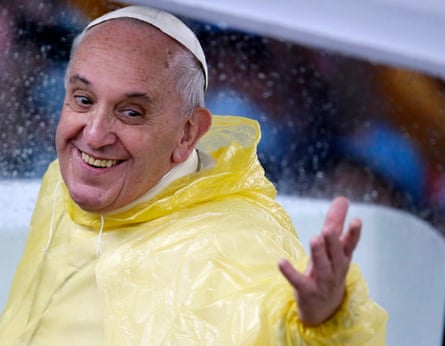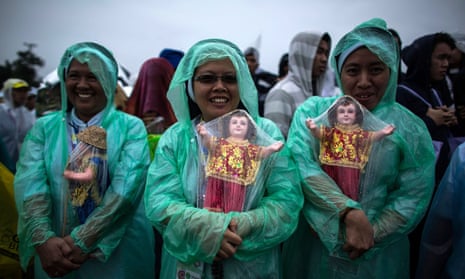In June, the Catholic church in the Philippines joined the One Million Against Coal Campaign, which aims to gather at least one million signatures nationwide in a bid to pressure the government to reverse the approval of dozens of coal power plants meant to address the country’s energy security concerns.
“We are strongly opposing coal energy because of its negative effects on the health of the people and the environment. Coal plants are the primary cause of global warming,” says Father Edwin Gariguez, executive director of Caritas Philippines National Secretariat for Social Action, the church’s social action arm.
The petition was announced days before Pope Francis called on the world to phase out the use of fossil fuels in his powerful 180-page encyclical on the environment. Gariguez told the Guardian the encyclical confirms they’re on the right track.
Although much of the church’s effort has centred on opposing fossil fuels, it’s taking a two-pronged approach to include clean energy use.
For instance, one project – a proposed 1,200-megawatt (MW) coal plant in Atimonan, 170km south of capital Manila – has met strong protests from locals, led by church leaders. These leaders are paving the way for renewable energy use by installing solar panels at their parish church.
“We’re encouraging our communities to adopt renewable energy sources by setting an example. This has not been cascaded to all Catholic churches nationwide, but that’s our hope. We’ll include this as part of our best practices,” Gariguez explains.
Yet there are challenges. Gariguez said the Church doesn’t have the funds to make renewable energy use a widespread effort. That’s why it’s turning to groups that may be able to help out.
Gariguez is in talks with a Norway-based NGO focusing on solar energy about a partnership to promote renewable energy use in off-grid and remote communities in the Philippines. If it works out – Gariguez declined to identify which group they’re talking to saying the negotiations are all still “exploratory” – the project will involve installing solar panels in schools and health districts.
“This is a step. We’re doing something,” he says.
The Catholic church plays a prominent role in the Philippines. With 76 million members, accounting for roughly 80% of the population – the biggest in Asia, it has the ability to influence public debate on any issue. For instance, church officials have stirred protests against mining, particularly open-pit mining techniques and mining laws, which they claim give too many incentives to foreign companies. Gariguez says they want to turn fossil fuels and clean energy into a mainstream issue as they did mining.
The church has joined hands with environmentalists and activists such as non-government organisation Philippine Movement for Climate Justice (PMCJ) in this goal. PMCJ is working with the church on the signature drive against coal. It was also part of the campaign that called for Norway to divest its over $8 billion fossil fuel investments, some of which were channeled to the Philippines.

“Together with the faith community and affected sectors, we are taking into account what the Pope is calling for and what the climate needs: a radical shift away from dirty energy, specifically coal, towards renewable energy,” PMCJ national coordinator Gerry Arances says. “The entry of the Catholic church in the climate scene is a much needed element to introduce the moral and ethical arguments into the climate debacle.”
But Gariguez believes there’s only so much they can do. He urges the government to do its part. “The church doesn’t have the financial capacity. What we can do is advocate for government to support renewable energy. We’ve had dialogues with them. But we’re tired. They’re insensitive and they’re not listening.”
Church leaders are blaming the government for failing to lay the groundwork for renewable energy fast enough so it could plug the energy requirement gap without having to tap more coal. The government had announced 23 new coal power plants would go online by 2020.
The Philippine economy is fast expanding, which means electricity demand is growing. The grid on Luzon, the country’s largest island where most business activities happen, has an installed capacity of 13,200 MW. But many power plants suffer outages because they’re old, while hydropower capacity falls during dry months, resulting to dwindling output and sometimes, rotating blackouts.
Mario Marasigan, director of the energy ministry’s renewable energy management bureau, says there are many factors weighing on the country’s renewable energy plan.
Renewable energy requires time to build – you have to find and validate a resource before you can develop it. It’s also more expensive to produce at the moment, though this is expected to get cheaper with better technology. In contrast, coal takes the shortest time. It’s the fastest way to cope with energy demand.
Marasigan also lamented that some renewable energy projects are facing delays due to opposition from local communities, sometimes even the church. This is the case in the province of Sorsogon, where a listed oil and gas company has received the green light to develop geothermal energy.
“The priest is objecting to the project, saying it will destroy the environment and bring about an ecological imbalance,” says Marasigan. “In general, the church is pro-renewable energy but there are isolated cases like this. We’re trying to educate them.”
Nonetheless, the energy ministry is ramping up renewable energy development to change the Philippines’ energy mix. In fact, it claims its renewable energy plan has picked up pace.
The Philippines targets a renewable energy supply of 15,300 MW by 2030 (pdf), about half of the energy demand forecast of 30,000 MW. Demand today stands at nearly 12,000 MW.
The goal is largely fuelled by cost considerations. The Philippines imports most of its fuel requirements, making it dependent on international markets. “We’re lessening our dependence on imported fuels,” say Marasigan. “By developing indigenous resources that are clean and green.”
Join our community of development professionals and humanitarians. Follow @GuardianGDP on Twitter. Join the conversation with the hashtag #EnergyAccess.

Comments (…)
Sign in or create your Guardian account to join the discussion